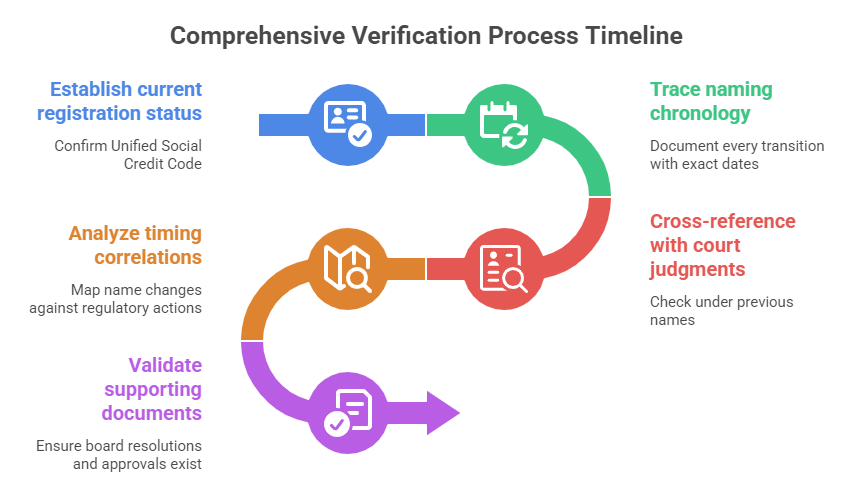When conducting business with Chinese companies, verifying historical name changes is a critical yet often overlooked aspect of due diligence. Corporate rebranding can sometimes mask underlying risks—from financial distress to ownership restructuring. This guide provides a comprehensive approach to investigating Chinese companies’ naming histories and interpreting the implications.

Why Company Name Changes Matter in China
Chinese enterprises may alter their registered names for legitimate reasons like:
- Rebranding to reflect new business directions
- Mergers or acquisitions requiring identity consolidation
- Compliance with regulatory naming requirements
However, frequent or suspicious name changes may indicate:
- Attempts to distance from past legal disputes
- Evasion of negative publicity or regulatory sanctions
- Ownership changes involving undisclosed parties
- Financial restructuring after insolvency events
A 2022 study by the China Market Regulatory Annual Report revealed that 23% of companies with administrative penalties underwent name changes within two years of enforcement actions.
Official Channels for Verifying Name Histories
1. National Enterprise Credit Information Publicity System (NECIPS)
China’s primary business registry maintains complete naming chronologies. Each record shows:
- Exact change dates
- Previous and subsequent names
- Associated registration number modifications
Access requires Chinese language navigation, though key fields can be translated using browser tools.
2. Local Administration for Market Regulation Offices
Provincial branches maintain archival records, including:
- Original name approval documents
- Board resolutions authorizing changes
- Government correspondence regarding naming compliance
3. Third-Party Verification Services
Specialized providers like ChinaBizInsight offer bilingual historical reports combining:
- Official NECIPS extracts
- Court records linked to previous identities
- Media scans for rebranding context
Our Professional Enterprise Credit Report integrates naming history with 11 other risk dimensions, providing context for changes.
Interpreting Name Change Patterns
Red Flags in Naming Histories
- Multiple changes within short periods (under 2 years)
- Complete shifts in naming conventions (e.g., from “Beijing [Industry]” to unrelated names)
- Reversions to previous names after brief intervals
- Discrepancies between Chinese and English naming records
Case Study: Hidden Risks Revealed
A European manufacturer nearly partnered with “Shanghai Golden Machinery Co.” until due diligence uncovered its prior identity as “Shanghai Trustworthy Equipment”—a company blacklisted for quality violations in 2019. The rebranding occurred three months after regulatory sanctions.
Step-by-Step Verification Process
- Establish current registration status
Confirm the Unified Social Credit Code matches across all documents - Trace naming chronology
Document every transition with exact dates - Cross-reference with:
- Court judgments under previous names
- Licensing and permit histories
- Media reports about rebranding events
- Analyze timing correlations
Map name changes against:- Regulatory actions
- Ownership transfers
- Financial reporting periods
- Validate supporting documents
Ensure board resolutions and government approvals exist for each transition
Common Challenges and Solutions
Challenge: Incomplete historical records
Solution: Request archival filings from local AMR offices where the company was originally registered
Challenge: Discrepancies in English/Chinese names
Solution: Verify which version appears on official seals and contracts—the Chinese name always takes legal precedence
Challenge: Mergers creating new entities
Solution: Trace predecessor companies through dissolution records and asset transfer agreements
Best Practices for Ongoing Monitoring
- Set up alerts for any registration changes through services like China Company Verification
- Maintain records of all historical identities when filing contracts
- Reverify naming status annually or before major transactions
Understanding why and how a Chinese company changed its name provides critical insights into its operational integrity. In China’s dynamic business environment, what a company chooses to call itself—and what it used to be called—often tells the real story behind the corporate facade.
